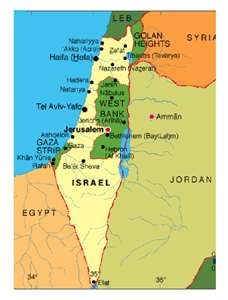 Our first destination in Jerusalem a few weeks ago was not our hotel but a large gift store. The proprietor and his staff served us hot tea and the Arab version of baklava. (It was yellow and as scrumptious as any Greek baklava I have ever had.) After giving us plenty of time for shopping, our guide Danny rounded up all 41 of us and led us down the street. One block away we arrived at what is regarded by Christians as the most holy site in Jerusalem, the Church of the Holy Sepulchre.
Our first destination in Jerusalem a few weeks ago was not our hotel but a large gift store. The proprietor and his staff served us hot tea and the Arab version of baklava. (It was yellow and as scrumptious as any Greek baklava I have ever had.) After giving us plenty of time for shopping, our guide Danny rounded up all 41 of us and led us down the street. One block away we arrived at what is regarded by Christians as the most holy site in Jerusalem, the Church of the Holy Sepulchre.
Under the roofs of the huge, sprawling building are found the traditional sites of Christ’s crucifixion (Golgotha), the stone where his body was laid for anointing by Joseph of Arimethea and his tomb (the Holy Sepulchre itself.). We held up at the door to allow other tourists to exit. As I waited, I saw two young women and a child. Their head scarves immediately told me that they were Palestinians. One was joyfully taking a picture of the other and the little girl. They were excited to be together and at the door of this holy place. As you and I might do, they wanted to record the moment with a photo.
I spoke to the one having her picture taken, and her English was very good. (I don’t think I know one word of Arabic.) With a few quick questions I learned that she lived in Jerusalem and as a Christian had made other visits to the church. The other woman was her sister, and she was making her first visit to the church. With that answer I knew why it was so important for these Christian women to take pictures at the door.
“Oh, where is she from?” I asked, assuming for a moment, that she lived in some distant country. The answer she gave me was startling. Her answer brought home the tragic divisions which divide the people of Israel and the Palestinian territories.
She lived in the West Bank. She lived less than thirty miles from Jerusalem and the Church of the Holy Sepulcher.
And why had it taken her so long to visit? Again, more surprise: because it was the first time she had been allowed to visit Jerusalem!
This is one encounter Kay and I want to speak about on March 7 and 14 in the fellowship hall. It taught me and re-minded me of several things. Many Pal-estinians are Christians. Many speak English. Their lives are deeply affected by the ongoing strife between the peo-ple of Israel and the people of Palestine.
And it reminded me of one more thing. Christ went to that cross and was laid in that tomb and was raised from that tomb for them, for all of them who live in that strife filled place.
See you in church on Sunday! And please invite your friends to join you for our presentations on March 7 and 14!
Paul
